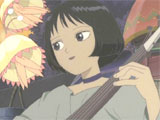

Quick Links:
A Tree of Palme (Palme no Ki)
Every once in a while, a work comes along that's a real eye-opener. Whether it's a clever twist on an old formula, or something so fantastical as to defy the imagination, these works make our view of the world a little broader than it was before. I believe A Tree of Palme to be such a work, not because of what it tells us, but because of what it shows us. It's a simple soul-searching tale enveloped within a world of unusual splendor and beauty.
The story of A Tree of Palme is largely based on Pinocchio. Palme is a talking puppet made from the wood of a kooloop tree. The kooloop's significant attribute is the ability to retain the memories of man, and so does Palme have this ability. Palme's journey begins as a search for his old mistress Xian, and later develops into a quest to become human. (The film borrows from its source mostly in principle, but it also draws a few similarities in plot where convenient. For instance, it's easy to travel when everyone's trying to sell you.) Four other characters aid Palme in his quest, one of them a girl named Popo - who Palme mistakes for Xian at first. She is perhaps most instrumental to his development, and the dynamic between the two is well-played.
The production for Palme had a very long planning stage (seven years), and it shows. Every detail; every town and person and event in the story had a specific role to fill in this spectacle of humanity. The director notes that this was his intent: Like Pinocchio, Palme would discover what it means to be human by witnessing a myriad of human behaviors - complete with the irony that he himself displays some of those behaviors without noticing. For the majority of the film, the meticulous plotting of Palme's journey works out for the better, because it allows for more focus on characterization.
There are often consequences to be had from such careful planning of a story, though. For one thing, it takes little skill on the part of the viewer to sniff out plotting, especially when the story borrows material from another well-known story. There are also several pitfalls to the approach, such as the continuity trap - transitioning between events becoming more tricky as more of the story is laid out. Once the viewer finds you out, any chance for giving them an experience that plays naturally to their emotions is gone. A Tree of Palme falls victim to the continuity trap only once or twice, but the effect can be jarring depending on the viewer. The most evident is a scene that was constructed to represent a loss of innocence. The event is intended to be a turning point, but its effects were too great for the it to line up smoothly with the other events.
Failing to steer clear of the pitfalls might have killed a normal film, but it didn't kill this one. The reason why is its visuals - pure, unadulterated bliss. The world in which Palme's story takes place has a surreal quality to it, as if it's a sort of above-ground ocean. The fascinating scenery features floating plants that look like jellyfish, and giant fish swimming through air with birds tagging along for the ride. The oceanic scenery as a metaphor for the subconscious is a clever touch, and it also works for the simple reason that it's gorgeous. The excellent color use and smoothly transitioning animations are a couple of the positive artifacts of the movie's laborious planning. It's even more impressive when considering that the animation was done entirely with cels.
Takashi Harada's music for A Tree of Palme seemed to have been as carefully created as with the other aspects of the film, but not as carefully integrated, I'm sad to say. I can't speak for anyone else's stream of consciousness, but in mine, the soundtrack doesn't get in the way. In Palme, the soundtrack does at times gel perfectly with a scene; but other times it's like those "hidden 3D image" posters. You know, the kind where everyone else seems to see the mythical hidden picture instantly, but you have to concentrate intensely to even have a chance, and you keep getting distracted by strange sounds? I recall a few scenes early in the film where I was perfectly happy with the experience, only to have the music Freddy Krueger the scene when - and this is only a theory - the piano player fell asleep and his head crashed down on the keys. Luckily, the scene-murdering whims of the soundtrack are few and far between. Overall it's a pleasant experience, and Akino Arai's lovely Sora no Aosa as the ending tune makes it even sweeter.
This movie's a keeper, folks. The faults I mention above will affect viewers to different degrees of course, but I feel the positives give a compelling reason for all to check this movie out - with parental discretion advised and all that. I spoke of this film as an eye-opener because the scenery is so unusual as to suggest a deeper reading of the plot - something that wouldn't have happened, had Nakamura simply made "another Pinocchio." The film is also a fresh reminder of how strikingly beautiful animation can be. It's quite the experience.
Distributor: ADV Films Creator: Takashi Nakamura / GENCO Released: 2002
Plot: A- Character Design: A Animation Quality: A+ Music: B+ Overall: A



